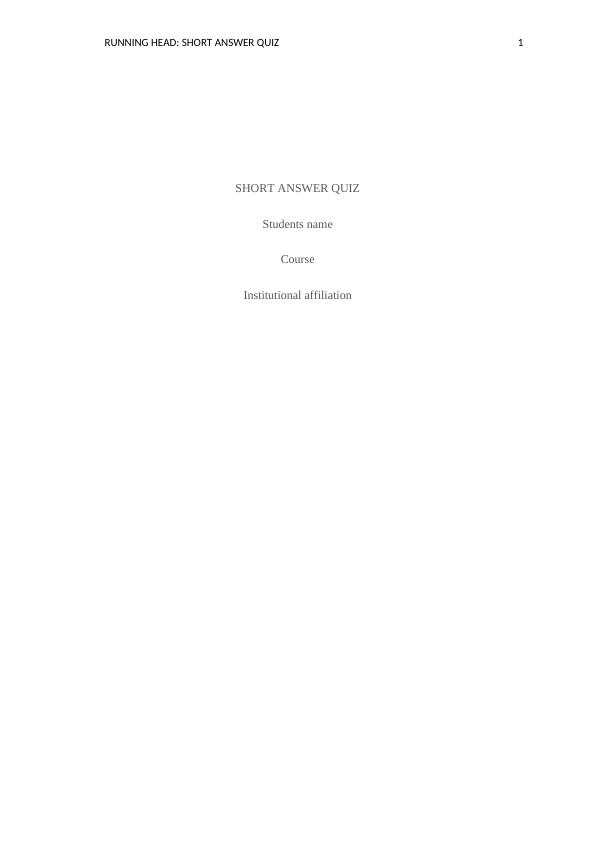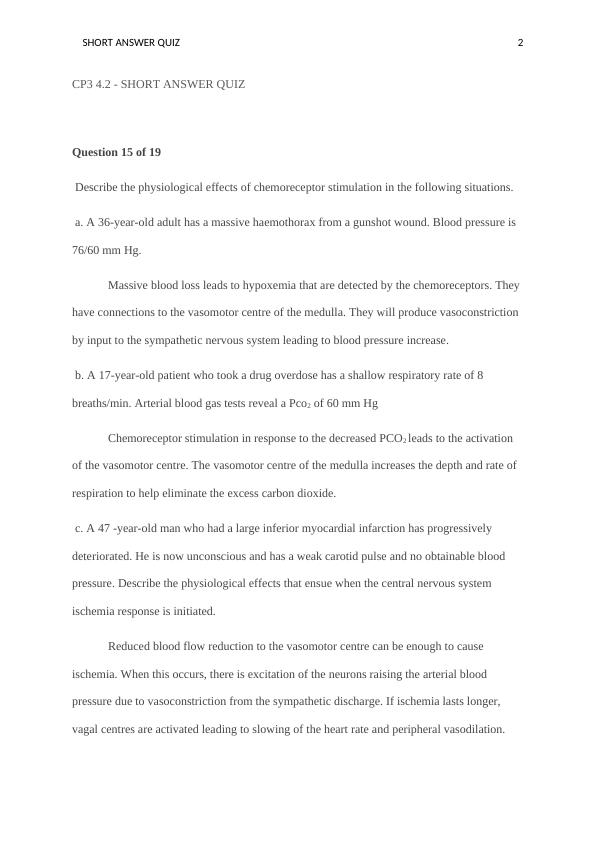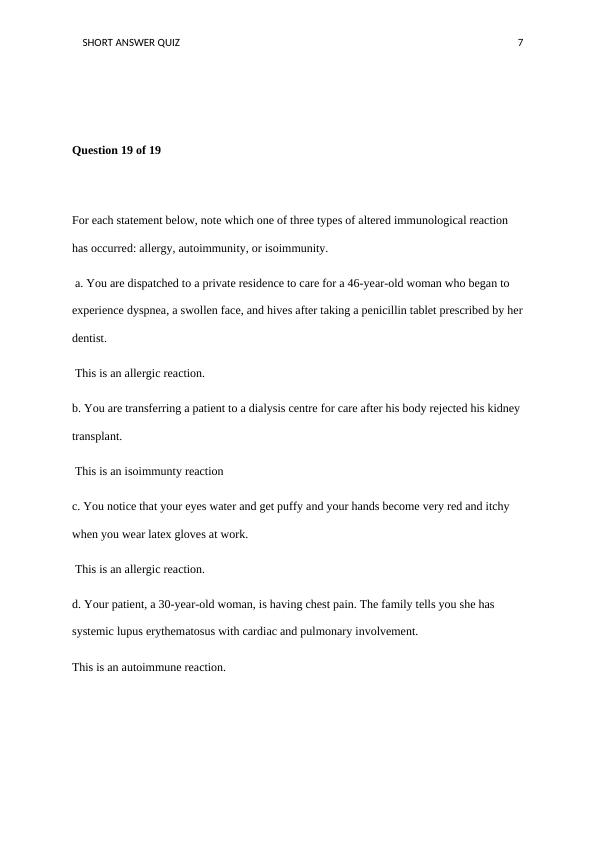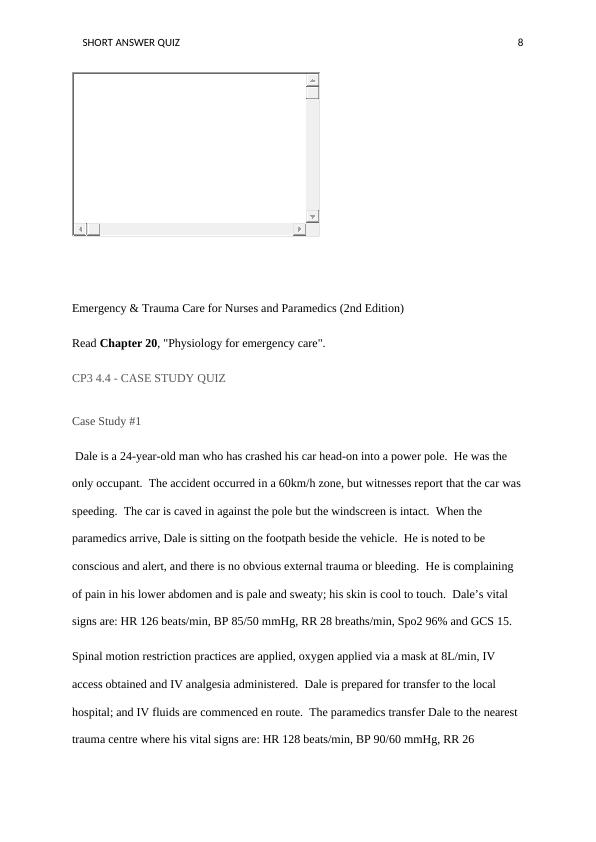Physiology for Emergency Care: Short Answer Quiz
Describe the physiological effects of chemoreceptor stimulation in different medical situations and the effects of hormonal mechanisms in a specific case.
31 Pages5191 Words114 Views
Added on 2023-06-11
About This Document
This short answer quiz tests your knowledge on physiology for emergency care. It covers topics such as the physiological effects of chemoreceptor stimulation, altered immunological reactions, and the body's response to a reduction in blood pressure. The quiz also includes a case study on a patient in hypovolemic shock.
Physiology for Emergency Care: Short Answer Quiz
Describe the physiological effects of chemoreceptor stimulation in different medical situations and the effects of hormonal mechanisms in a specific case.
Added on 2023-06-11
ShareRelated Documents
RUNNING HEAD: SHORT ANSWER QUIZ 1
SHORT ANSWER QUIZ
Students name
Course
Institutional affiliation
SHORT ANSWER QUIZ
Students name
Course
Institutional affiliation

SHORT ANSWER QUIZ 2
CP3 4.2 - SHORT ANSWER QUIZ
Question 15 of 19
Describe the physiological effects of chemoreceptor stimulation in the following situations.
a. A 36-year-old adult has a massive haemothorax from a gunshot wound. Blood pressure is
76/60 mm Hg.
Massive blood loss leads to hypoxemia that are detected by the chemoreceptors. They
have connections to the vasomotor centre of the medulla. They will produce vasoconstriction
by input to the sympathetic nervous system leading to blood pressure increase.
b. A 17-year-old patient who took a drug overdose has a shallow respiratory rate of 8
breaths/min. Arterial blood gas tests reveal a Pco2 of 60 mm Hg
Chemoreceptor stimulation in response to the decreased PCO2 leads to the activation
of the vasomotor centre. The vasomotor centre of the medulla increases the depth and rate of
respiration to help eliminate the excess carbon dioxide.
c. A 47 -year-old man who had a large inferior myocardial infarction has progressively
deteriorated. He is now unconscious and has a weak carotid pulse and no obtainable blood
pressure. Describe the physiological effects that ensue when the central nervous system
ischemia response is initiated.
Reduced blood flow reduction to the vasomotor centre can be enough to cause
ischemia. When this occurs, there is excitation of the neurons raising the arterial blood
pressure due to vasoconstriction from the sympathetic discharge. If ischemia lasts longer,
vagal centres are activated leading to slowing of the heart rate and peripheral vasodilation.
CP3 4.2 - SHORT ANSWER QUIZ
Question 15 of 19
Describe the physiological effects of chemoreceptor stimulation in the following situations.
a. A 36-year-old adult has a massive haemothorax from a gunshot wound. Blood pressure is
76/60 mm Hg.
Massive blood loss leads to hypoxemia that are detected by the chemoreceptors. They
have connections to the vasomotor centre of the medulla. They will produce vasoconstriction
by input to the sympathetic nervous system leading to blood pressure increase.
b. A 17-year-old patient who took a drug overdose has a shallow respiratory rate of 8
breaths/min. Arterial blood gas tests reveal a Pco2 of 60 mm Hg
Chemoreceptor stimulation in response to the decreased PCO2 leads to the activation
of the vasomotor centre. The vasomotor centre of the medulla increases the depth and rate of
respiration to help eliminate the excess carbon dioxide.
c. A 47 -year-old man who had a large inferior myocardial infarction has progressively
deteriorated. He is now unconscious and has a weak carotid pulse and no obtainable blood
pressure. Describe the physiological effects that ensue when the central nervous system
ischemia response is initiated.
Reduced blood flow reduction to the vasomotor centre can be enough to cause
ischemia. When this occurs, there is excitation of the neurons raising the arterial blood
pressure due to vasoconstriction from the sympathetic discharge. If ischemia lasts longer,
vagal centres are activated leading to slowing of the heart rate and peripheral vasodilation.

SHORT ANSWER QUIZ 3
Question 16 of 19
A 65-year-old alcoholic man states that he had a sudden onset of vomiting. The emesis
contains bright red blood, and he continues to vomit. Vital signs are blood pressure - 94/78
mm Hg - pulse - 132 beats/min (bpm) and respirations - 28 breaths/min. Describe the effects
of the following three hormonal mechanisms, which will be activated.
a. Adrenal medullary mechanism
The medulla produces primarily the catecholamines epinephrine, norepinephrine and
dopamine (Wong, 2006). During physiologic, physical or environmental stress for example
bleeding in this case, the body perceives a threat to normal homeostatic balance and initiates
a response via the hypothalamus (Barrett, Barman, Boitano, & Brooks, 2009). A sympathetic
nervous discharge will travel through the spinal cord and the sympathetic preganglionic
neuron to synapse with chromaffin cells of the adrenal medulla to release mainly epinephrine
(De Diego, Gandia, & Garcia, 2008). Epinephrine has various effects on target organs
including increasing the heart rate, blood pressure, vessel constriction to divert blood from
non-essential organs like skin to more essential organs like heart and brain, increasing the
metabolic rate and pupillary dilatation just to name a few (Waugh & Grant, 2010).
b. Renin-angiotensin-aldosterone mechanism
Bleeding causes a reduction in renal blood flow which is detected by the
juxtaglomerular cells of the kidney (Moon, 2013). They secrete renin, which enzymatically
turns angiotensinogen to angiotensin 1. Angiotensin 1 is then turned by angiotensin
converting enzyme to angiotensin 2 a potent vasoconstrictor that increases the peripheral
resistance hence the blood pressure. It also stimulates the adrenal cortex to produce
Question 16 of 19
A 65-year-old alcoholic man states that he had a sudden onset of vomiting. The emesis
contains bright red blood, and he continues to vomit. Vital signs are blood pressure - 94/78
mm Hg - pulse - 132 beats/min (bpm) and respirations - 28 breaths/min. Describe the effects
of the following three hormonal mechanisms, which will be activated.
a. Adrenal medullary mechanism
The medulla produces primarily the catecholamines epinephrine, norepinephrine and
dopamine (Wong, 2006). During physiologic, physical or environmental stress for example
bleeding in this case, the body perceives a threat to normal homeostatic balance and initiates
a response via the hypothalamus (Barrett, Barman, Boitano, & Brooks, 2009). A sympathetic
nervous discharge will travel through the spinal cord and the sympathetic preganglionic
neuron to synapse with chromaffin cells of the adrenal medulla to release mainly epinephrine
(De Diego, Gandia, & Garcia, 2008). Epinephrine has various effects on target organs
including increasing the heart rate, blood pressure, vessel constriction to divert blood from
non-essential organs like skin to more essential organs like heart and brain, increasing the
metabolic rate and pupillary dilatation just to name a few (Waugh & Grant, 2010).
b. Renin-angiotensin-aldosterone mechanism
Bleeding causes a reduction in renal blood flow which is detected by the
juxtaglomerular cells of the kidney (Moon, 2013). They secrete renin, which enzymatically
turns angiotensinogen to angiotensin 1. Angiotensin 1 is then turned by angiotensin
converting enzyme to angiotensin 2 a potent vasoconstrictor that increases the peripheral
resistance hence the blood pressure. It also stimulates the adrenal cortex to produce

SHORT ANSWER QUIZ 4
aldosterone, a hormone whose principle action is salt and water retention (Moon, 2013). This
aims to increase blood volume, cardiac output, and blood pressure.
c. Vasopressin mechanism
Vasopressin is released from the posterior pituitary in response to sympathetic activity
and hyperosmolarity of blood. It is released into circulation to exert its effects on the kidneys
and the blood vessels. In the blood vessels it is a powerful vasoconstrictor reducing which in
this case would raise the blood pressure by increasing the peripheral resistance. In the kidney
it promotes water reabsorption maintaining blood volume, cardiac output and in turn blood
pressure.
Complete the following paragraph using the following words/ phrases:
cellular acidosis and impaired cellular function
coagulation
complement, coagulation and kallikrein/kinin
endothelium
endotoxins and inflammatory mediators
hypotension and hypoperfusion
interstitial
oedema formation, cardiovascular instability and clotting abnormalities
organ
permeable
systemic vascular resistance
thrombus
vascular endothelial
aldosterone, a hormone whose principle action is salt and water retention (Moon, 2013). This
aims to increase blood volume, cardiac output, and blood pressure.
c. Vasopressin mechanism
Vasopressin is released from the posterior pituitary in response to sympathetic activity
and hyperosmolarity of blood. It is released into circulation to exert its effects on the kidneys
and the blood vessels. In the blood vessels it is a powerful vasoconstrictor reducing which in
this case would raise the blood pressure by increasing the peripheral resistance. In the kidney
it promotes water reabsorption maintaining blood volume, cardiac output and in turn blood
pressure.
Complete the following paragraph using the following words/ phrases:
cellular acidosis and impaired cellular function
coagulation
complement, coagulation and kallikrein/kinin
endothelium
endotoxins and inflammatory mediators
hypotension and hypoperfusion
interstitial
oedema formation, cardiovascular instability and clotting abnormalities
organ
permeable
systemic vascular resistance
thrombus
vascular endothelial

SHORT ANSWER QUIZ 5
Multiple organ dysfunction syndrome (MODS) begins with (a) damage caused
by (b) which are released into the circulation. This causes the vascular (c)
to become (d) , which allows fluid and cells to leak into the (e)
spaces, increasing (f) . Three plasma enzyme cascades are then
activated. They are (g) . Phagocytes cause further
damage to the endothelium, causing uncontrolled (h) and the formation of
microvascular (i) and tissue ischemia. Bradykinin contributes to low (j)
. The overall effect of the three complement systems is (k)
. Initially, the body compensates for
these changes, but ultimately tissue hypoxia causes (l) .
Finally, multiple (m) failure occurs.
Q 17
Your partner is off sick with a diagnosis of strep throat. Describe whether the following signs
and symptoms experienced during this illness are local or systemic and give at least one
inflammatory mechanism that causes the sign or symptom.
a. Oedematous throat
This is a local sign. It is due to serous pattern of inflammation. During inflammation,
inflammatory mediators are release in response to a pathogen. As part of the vascular
vascular endothe
endotoxins and in
endothelium permeable
interstitial hypotension and h
coagulation and kallikrein/ kinin
coagulation
thrombus
systemic vascular
cardiovascular instability and clotting abnormalities
impaired cellular function
organ
Multiple organ dysfunction syndrome (MODS) begins with (a) damage caused
by (b) which are released into the circulation. This causes the vascular (c)
to become (d) , which allows fluid and cells to leak into the (e)
spaces, increasing (f) . Three plasma enzyme cascades are then
activated. They are (g) . Phagocytes cause further
damage to the endothelium, causing uncontrolled (h) and the formation of
microvascular (i) and tissue ischemia. Bradykinin contributes to low (j)
. The overall effect of the three complement systems is (k)
. Initially, the body compensates for
these changes, but ultimately tissue hypoxia causes (l) .
Finally, multiple (m) failure occurs.
Q 17
Your partner is off sick with a diagnosis of strep throat. Describe whether the following signs
and symptoms experienced during this illness are local or systemic and give at least one
inflammatory mechanism that causes the sign or symptom.
a. Oedematous throat
This is a local sign. It is due to serous pattern of inflammation. During inflammation,
inflammatory mediators are release in response to a pathogen. As part of the vascular
vascular endothe
endotoxins and in
endothelium permeable
interstitial hypotension and h
coagulation and kallikrein/ kinin
coagulation
thrombus
systemic vascular
cardiovascular instability and clotting abnormalities
impaired cellular function
organ

SHORT ANSWER QUIZ 6
response there is redness due to increased vascularity with oedema due to outpouring of fluid
from the leaky dilated vascular channel
b. Purulent drainage
This is also a local symptom and is due to suppurative inflammation. There is
attraction of leukocytes to the injury site. It is manifested by collection of purulent exudate
consisting of dead neutrophils, oedema fluid and necrotic tissue.
c. Fever
Fever is a systemic sign. It is caused by release of cytokines into circulation that reset
the body’s thermoregulation mechanisms leading to failure of heat regulation.
d. Red throat
This is a local sign and is due to increased vascularity at the inflammatory site as the
body tries to mobilize inflammatory mediatory to reach the area.
e. Difficulty swallowing
This is also a local symptom and could be attributed to the inflammatory process that
causes exudation of fluid into the interstitial space leading to oedema and narrowing of the
food passage.
response there is redness due to increased vascularity with oedema due to outpouring of fluid
from the leaky dilated vascular channel
b. Purulent drainage
This is also a local symptom and is due to suppurative inflammation. There is
attraction of leukocytes to the injury site. It is manifested by collection of purulent exudate
consisting of dead neutrophils, oedema fluid and necrotic tissue.
c. Fever
Fever is a systemic sign. It is caused by release of cytokines into circulation that reset
the body’s thermoregulation mechanisms leading to failure of heat regulation.
d. Red throat
This is a local sign and is due to increased vascularity at the inflammatory site as the
body tries to mobilize inflammatory mediatory to reach the area.
e. Difficulty swallowing
This is also a local symptom and could be attributed to the inflammatory process that
causes exudation of fluid into the interstitial space leading to oedema and narrowing of the
food passage.

SHORT ANSWER QUIZ 7
Question 19 of 19
For each statement below, note which one of three types of altered immunological reaction
has occurred: allergy, autoimmunity, or isoimmunity.
a. You are dispatched to a private residence to care for a 46-year-old woman who began to
experience dyspnea, a swollen face, and hives after taking a penicillin tablet prescribed by her
dentist.
This is an allergic reaction.
b. You are transferring a patient to a dialysis centre for care after his body rejected his kidney
transplant.
This is an isoimmunty reaction
c. You notice that your eyes water and get puffy and your hands become very red and itchy
when you wear latex gloves at work.
This is an allergic reaction.
d. Your patient, a 30-year-old woman, is having chest pain. The family tells you she has
systemic lupus erythematosus with cardiac and pulmonary involvement.
This is an autoimmune reaction.
Question 19 of 19
For each statement below, note which one of three types of altered immunological reaction
has occurred: allergy, autoimmunity, or isoimmunity.
a. You are dispatched to a private residence to care for a 46-year-old woman who began to
experience dyspnea, a swollen face, and hives after taking a penicillin tablet prescribed by her
dentist.
This is an allergic reaction.
b. You are transferring a patient to a dialysis centre for care after his body rejected his kidney
transplant.
This is an isoimmunty reaction
c. You notice that your eyes water and get puffy and your hands become very red and itchy
when you wear latex gloves at work.
This is an allergic reaction.
d. Your patient, a 30-year-old woman, is having chest pain. The family tells you she has
systemic lupus erythematosus with cardiac and pulmonary involvement.
This is an autoimmune reaction.

SHORT ANSWER QUIZ 8
Emergency & Trauma Care for Nurses and Paramedics (2nd Edition)
Read Chapter 20, "Physiology for emergency care".
CP3 4.4 - CASE STUDY QUIZ
Case Study #1
Dale is a 24-year-old man who has crashed his car head-on into a power pole. He was the
only occupant. The accident occurred in a 60km/h zone, but witnesses report that the car was
speeding. The car is caved in against the pole but the windscreen is intact. When the
paramedics arrive, Dale is sitting on the footpath beside the vehicle. He is noted to be
conscious and alert, and there is no obvious external trauma or bleeding. He is complaining
of pain in his lower abdomen and is pale and sweaty; his skin is cool to touch. Dale’s vital
signs are: HR 126 beats/min, BP 85/50 mmHg, RR 28 breaths/min, Spo2 96% and GCS 15.
Spinal motion restriction practices are applied, oxygen applied via a mask at 8L/min, IV
access obtained and IV analgesia administered. Dale is prepared for transfer to the local
hospital; and IV fluids are commenced en route. The paramedics transfer Dale to the nearest
trauma centre where his vital signs are: HR 128 beats/min, BP 90/60 mmHg, RR 26
Emergency & Trauma Care for Nurses and Paramedics (2nd Edition)
Read Chapter 20, "Physiology for emergency care".
CP3 4.4 - CASE STUDY QUIZ
Case Study #1
Dale is a 24-year-old man who has crashed his car head-on into a power pole. He was the
only occupant. The accident occurred in a 60km/h zone, but witnesses report that the car was
speeding. The car is caved in against the pole but the windscreen is intact. When the
paramedics arrive, Dale is sitting on the footpath beside the vehicle. He is noted to be
conscious and alert, and there is no obvious external trauma or bleeding. He is complaining
of pain in his lower abdomen and is pale and sweaty; his skin is cool to touch. Dale’s vital
signs are: HR 126 beats/min, BP 85/50 mmHg, RR 28 breaths/min, Spo2 96% and GCS 15.
Spinal motion restriction practices are applied, oxygen applied via a mask at 8L/min, IV
access obtained and IV analgesia administered. Dale is prepared for transfer to the local
hospital; and IV fluids are commenced en route. The paramedics transfer Dale to the nearest
trauma centre where his vital signs are: HR 128 beats/min, BP 90/60 mmHg, RR 26

End of preview
Want to access all the pages? Upload your documents or become a member.
Related Documents
Control of Blood Pressure - Mechanisms and Treatmentlg...
|4
|785
|50
Neuroscience & Biobehavioral Reviewslg...
|13
|2755
|14
Acute Exacerbation of the Chronic Heart Failure - Pathophysiology and Nursing Strategieslg...
|7
|1600
|240
